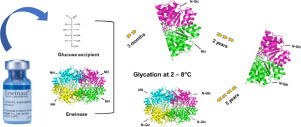当前位置:
X-MOL 学术
›
Eur. J. Pharm. Sci.
›
论文详情
Our official English website, www.x-mol.net, welcomes your
feedback! (Note: you will need to create a separate account there.)
Determination of glycation levels in Erwinia chrysanthemi asparaginase drug product by liquid chromatography - mass spectrometry.
European Journal of Pharmaceutical Sciences ( IF 4.3 ) Pub Date : 2020-02-04 , DOI: 10.1016/j.ejps.2020.105253 Patrick Kanda 1 , Thomas C Minshull 1
European Journal of Pharmaceutical Sciences ( IF 4.3 ) Pub Date : 2020-02-04 , DOI: 10.1016/j.ejps.2020.105253 Patrick Kanda 1 , Thomas C Minshull 1
Affiliation

|
Erwinase (Erwinia chrysanthemi L-asparaginase) Drug Product (DP) is a freeze-dried formulation with a three-year shelf life at 2-8 °C, and an established safety, stability and efficacy profile over the more than three decades of clinical use. Seven Erwinase® DP batches, released over a 7-year period, were screened by reversed-phase liquid chromatography coupled to time-of-flight mass spectrometry for glycation levels. This modification is a known and natural consequence of exposure of Erwinase Drug Product to glucose excipients in stabilizing formulations. Although glycation is detected in current release and stability methods, glycation, including the conditions under which this reaction occurs, has not been previously characterised in detail. We have found that glycation levels of different DP lots generally correlated with age, when they were stored at low temperature. This suggests that the glycation reaction continues over time within the Drug Product formulation in the lyophilised state, even under low temperature (+2-8 °C) conditions. We were also able to examine glycation levels of one DP lot, Lot D, held under long term stability at 3 different temperatures over a 5-year period. The 2 samples held at -20 °C and -80 °C, were glycated to levels of 12% and 17%, respectively. However, the DP Lot D sample held at +2-8 oC in this time period was found to be glycated to a level of 35.6%, with multiple glycations of individual subunits observed. For analytical reference materials, it is important to keep parameters such as glycation levels as constant as possible, to avoid a 'moving target' with respect to comparisons with release and stability testing. These data suggest that storage of DP as reference standards at a lower temperature (e.g., -20 °C) can significantly reduce levels of glycation over the longer time periods required for analytical reference standards.
中文翻译:

液相色谱-质谱法测定菊花欧文氏菌门冬酰胺酶药物产品中的糖基化水平。
欧文氏酶(Erwinia chrysanthemi L-天冬酰胺酶)药品(DP)是一种冷冻干燥的制剂,在2-8°C下可保存三年,在超过三十年的临床使用中具有公认的安全性,稳定性和有效性采用。通过反相液相色谱与飞行时间质谱联用的糖化水平筛选了7年中释放的7批DP批次的Erwinase®DP。这种修饰是稳定制剂中欧文酶药物产品与葡萄糖赋形剂接触的已知自然结果。尽管在当前的释放和稳定性方法中检测到糖基化,但是糖基化,包括该反应发生的条件,以前没有被详细表征。我们发现,不同DP批次的糖化水平通常与年龄相关,当它们低温保存时。这表明即使在低温(+ 2-8°C)条件下,在冻干状态的药物制剂中,糖化反应也会随着时间的推移而持续。我们还能够检查一个DP批次D的糖化水平,该批次在5年内在3种不同温度下长期保持稳定。将分别在-20°C和-80°C下保存的2个样品糖化至12%和17%的水平。然而,发现在此时间段内保持在+ 2-8 oC的DP Lot D样品糖化至35.6%的水平,观察到各个亚基的多次糖化。对于分析性参考材料,重要的是保持参数(如糖化水平)尽可能恒定,以避免相对于与释放和稳定性测试进行比较时出现的“移动目标”。
更新日期:2020-02-04
中文翻译:

液相色谱-质谱法测定菊花欧文氏菌门冬酰胺酶药物产品中的糖基化水平。
欧文氏酶(Erwinia chrysanthemi L-天冬酰胺酶)药品(DP)是一种冷冻干燥的制剂,在2-8°C下可保存三年,在超过三十年的临床使用中具有公认的安全性,稳定性和有效性采用。通过反相液相色谱与飞行时间质谱联用的糖化水平筛选了7年中释放的7批DP批次的Erwinase®DP。这种修饰是稳定制剂中欧文酶药物产品与葡萄糖赋形剂接触的已知自然结果。尽管在当前的释放和稳定性方法中检测到糖基化,但是糖基化,包括该反应发生的条件,以前没有被详细表征。我们发现,不同DP批次的糖化水平通常与年龄相关,当它们低温保存时。这表明即使在低温(+ 2-8°C)条件下,在冻干状态的药物制剂中,糖化反应也会随着时间的推移而持续。我们还能够检查一个DP批次D的糖化水平,该批次在5年内在3种不同温度下长期保持稳定。将分别在-20°C和-80°C下保存的2个样品糖化至12%和17%的水平。然而,发现在此时间段内保持在+ 2-8 oC的DP Lot D样品糖化至35.6%的水平,观察到各个亚基的多次糖化。对于分析性参考材料,重要的是保持参数(如糖化水平)尽可能恒定,以避免相对于与释放和稳定性测试进行比较时出现的“移动目标”。











































 京公网安备 11010802027423号
京公网安备 11010802027423号